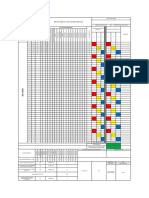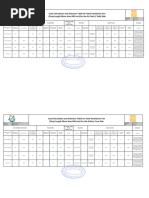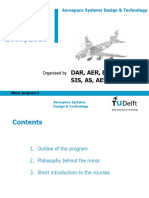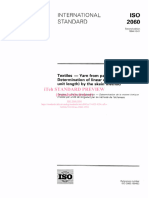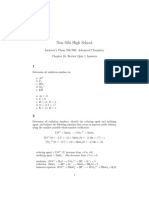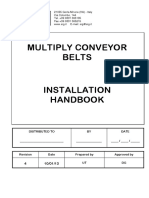Structural Analysis and Design Group: National Aerospace Laboratories, Bangalore
Structural Analysis and Design Group: National Aerospace Laboratories, Bangalore
Uploaded by
alagarg137691Copyright:
Available Formats
Structural Analysis and Design Group: National Aerospace Laboratories, Bangalore
Structural Analysis and Design Group: National Aerospace Laboratories, Bangalore
Uploaded by
alagarg137691Original Description:
Original Title
Copyright
Available Formats
Share this document
Did you find this document useful?
Is this content inappropriate?
Copyright:
Available Formats
Structural Analysis and Design Group: National Aerospace Laboratories, Bangalore
Structural Analysis and Design Group: National Aerospace Laboratories, Bangalore
Uploaded by
alagarg137691Copyright:
Available Formats
National Aerospace Laboratories, Bangalore
Structural Analysis and Design Group
FINITE ELEMENT STRESS ANALYSIS AND DESIGN OPTIMISATION OF OPTIMUM STRUCTURAL DESIGN OF SARAS COMPOSITE WING
AEROSPACE STRUCTURES
Metallic Leading Edge
A. PROJECTS:
1. Design Optimisation and Stress Analysis Support for Civil Transport Aircraft Programmes: CFC Top Skin
Aileron
a.AEW (Airborne Early Warning ) Aircraft Fuselage Attachment
Skin
b.HANSA Programme O/B Flap
c.SARAS Programme
Symmetry
d.SARAS Production Standard Aircraft: Design optimisation of composite wing Elasto-plastic analysis of local high- Plane
stress regions of SARAS wing CFC Aft Skin
I/B Flap
2.Design and Stress Analysis Support for Reusable Launch Vehicle –Technology Demonstrator
for VSSC, Trivandrum.
3.Non-linear Stress Analysis of LTA (Lighter Than Air ) Vehicles:
a. Two Thousand cu. m. AKASHDEEP Aerostat for ADRDE, AGRA
b. NAL BLIMP: Multi-purpose 300 cu. m. air ship for civil applications
4. Design and Analysis of RADOMES for Civil and Military Applications
5. Computational Vibro Acoustics: Passive Control of SARAS Cabin Noise
B. SOFTWARE PACKAGES:
a. ABAQUS: STANDARD/EXPLICT
b. ACTRAN: FE-based Acoustics SW
c. MSC/NASTRAN
d. MSC/DYTRAN
e. MSC/PATRAN, HYPERMESH, FEMAP
Optimised Weight of CFC Wing
210.00
C: FUTURE WORK: W
e
Limit Load
Ultimate Load Optimum Weight Optimum
CONTACT: i
g
205.00
Sl.
Description
of Weight of
Remarks
h 200.00
No Half-Wing Full-Wing
Multi-Disciplinary Optimisation Head, Structural Technologies Division t . Kg kg
High Altitude Airship NAL, Bangalore R
195.00
Excludes nose
Weight of Torque
e 1 162.27 324.54 box flap&
t
190.00
Box
aileron
a
185.00
i Includes Nose
n Weight of Clean
2 177.49 354.98 Box weight of
e 180.00
Wing
d 15.22 kg
, 175.00
k 0 2 4 6 8 10 12 14 16 Includes Flap
g Design Cycle No Weight with Flap and Aileron
3 205.88 411.76
Optimisation of CFC Half-Wing: & Aileron Weight of
Design Cycle vs. Weight retained at the End of the Design Cycle 28.39 kg
Analytical & Computational Modeling of Aircraft Structures Using Numerical Simulations on Ductile Fracture of Pressure Sensitive Solids
Fracture Mechanics Approach
Background: Importance and motivation Motivation: Many important engineering materials including metals exhibit pressure sensitive yielding
Designing against fracture is important in aircraft structures, since the presence of cracks would modify the local stresses to
and volume change during plastic deformation (plastic dilatancy) to some extent. This type of material
such an extent that the elastic stress analyses are inadequate. When a crack reaches a certain critical length, it can propagate behavior is ignored in classical metal plasticity theory but can profoundly influence ductile fracture.
catastrophically through the structure, even though the gross stresses are much less than the material yield strength. Fracture
mechanics p principles
p need to be deployed
p y to ensure damage g tolerant design
g of airframes. It assumes a p pre-existing
g crack,, and Objective: To systematically study the effects of pressure sensitive plastic response on ductile fracture.
determines the quantitative relations between the crack length, the inherent resistance of the material to crack growth, and the
stress at which the crack propagates at high speed leading to structural failure. Therefore, the present study is essential for the
damage tolerance analysis and a systematic review of design procedures that are required to design, manufacture, and maintain
Approach: 2D and 3D numerical simulations using ABAQUS, in‐house developed programs and 2D
airframes that are structurally safe and economically prudent. analytical solutions under different mode mixities (Mode I + II) and constraint levels
Focus & objectives Applicability: Fracture problems in metals, polymers, toughened ceramics, metallic glasses
¾Finite element analysis related to crack initiation and crack growth studies in metallic and composite structures
¾Post buckling analysis of composite structures
σ3 σh
¾Analytical and finite element solution for determining the crack tip parameters using fracture mechanics principle
Schematic of organization of the programme
Mises
σ1
Analytical & computational Analytical & numerical Computational fracture Computational fracture
fracture analysis of metallic fracture analysis of analysis for metallic & analysis for delamination σ2 Drucker‐Prager
plates for SIF
SIF, SERR orthotropic & laminated composite skin/stiffener propagation & post buckling
calculation composite plates structures studies
Yield surfaces in stress space Near‐tip FE mesh with notch and void Hydrostatic stress contours
Major results
h
¾Analytical solution for Stress Intensity factors in the case of isotropic and orthotropic plates
¾Finite element solution for strain energy release rate in composite structures crack
Major achievements
Small load (plastic zone << h)
Publications
Fracture resistance curves
International Journals: 4 Notch and Void growth
Algorithms: Integral transform technique and Finite element method
Publications
Applications Aircraft structural damage tolerant analysis 1. Subramanya, H. Y. et al., A three‐dimensional numerical
study of mode I crack tip fields in pressure sensitive
Outstanding Scientific issues: Development of Cohesive fracture models
plastic solids (Int.
(Int Journal of Sol.
Sol & Str.
Str 2007)
Collaboration & networking: - 2. Subramanya, H. Y. et al., Influence of crack tip
constraint on void growth in pressure sensitive plastic
Contact: Head, Structural Technologies Division, NAL, Bangalore Large load (plastic zone ≈ 0.5 h) solids‐I: 2D analysis (Engg. Fracture Mechanics 2008)
3. Subramanya, H. Y. et al., Constraint effects on multiple
Future plan & perspective: 3D plastic zone evolution void interaction in pressure sensitive plastic solids
Plastic strain contours (Engg. Fracture Mechanics 2008)
Skin-stiffener structures are common features of airframes. Cracks can occur in such structures in the vicinity of the stiffener. 4. Subramanya, H. Y., et al., Influence of crack tip
Aircraft structures are basically wing skins with bonded stringers. Since skin-stiffener separation is a potential damage mode constraint on spherical void growth in pressure
that disturbs the integrity of the structure, in the present study, the competing damage types namely delamination and skin-
Outcome: Pressure sensitive yielding affects both ductile sensitive plastic solids. (IQICF‐India 2008)
stiffener debond will be considered. Computational methodology will be developed by deploying the cohesive theory to study fracture initiation and tearing modulus. Further deterioration 5. Subramanya, H. Y. et al., A three‐dimensional numerical
study of mixed mode (I and II) crack tip fields in elastic‐
the debond failure of a typical skin-stiffener structure. This project would serve as an important tool for the on-going occurs in presence of plastic incompressibility. Irrespective of plastic solids. (Int. Journal of Fracture 2005)
composite aircraft design projects at NAL. 6. Narasimhan R., et al., Stationary crack tip fields in
pressure sensitivity, constraint loss results in enhancement of
elastic‐plastic solids: An overview of recent numerical
fracture resistance. simulations. (Journal of Physics D: Appl. Physics. 2009)
You might also like
- ITTO Matrix 6thed MatrixDocument13 pagesITTO Matrix 6thed MatrixGillianiNo ratings yet
- BSIT22 2ndDocument2 pagesBSIT22 2ndmuhammadertaza620No ratings yet
- Power Duct Air Intake OpeningDocument2 pagesPower Duct Air Intake OpeningMirNo ratings yet
- GCU Consultants (Johor) SDN BHD: General Notes and Miscellaneous Detail 3Document1 pageGCU Consultants (Johor) SDN BHD: General Notes and Miscellaneous Detail 3TOM YEENo ratings yet
- FAA 2018 0589 0005 - Attachment - 2Document10 pagesFAA 2018 0589 0005 - Attachment - 2hossein kavehNo ratings yet
- 2x2 reinfDocument1 page2x2 reinfsudipswain1871No ratings yet
- Demand Load CB Cable Installation MethodDocument1 pageDemand Load CB Cable Installation MethodiunitedfactorysaNo ratings yet
- Guidance Pub Version High AmendDocument44 pagesGuidance Pub Version High AmendCPAERICNo ratings yet
- Second Floorplan: College of Fisheries and Ocean ScienceDocument1 pageSecond Floorplan: College of Fisheries and Ocean ScienceArabella MagallanesNo ratings yet
- GDU System Architecture P79 04-03-23 FINALDocument4 pagesGDU System Architecture P79 04-03-23 FINALbennsavyaalrawafNo ratings yet
- GDU1 - System Architecture REV B - V1Document5 pagesGDU1 - System Architecture REV B - V1bennsavyaalrawafNo ratings yet
- TPE 331 EvolutionDocument7 pagesTPE 331 Evolutionjohn kasich100% (1)
- Sample Template - Branch Circuit Panel Board ScheduleDocument1 pageSample Template - Branch Circuit Panel Board Schedulemusleh19No ratings yet
- Pipe CulvertDocument8 pagesPipe Culvertmarlon matusalemNo ratings yet
- 2023 - 09 - 07 600+115 PierDocument2 pages2023 - 09 - 07 600+115 Piersubhankar biswasNo ratings yet
- Handing Over SEW - Manholes (Blank)Document2 pagesHanding Over SEW - Manholes (Blank)refoel.revanNo ratings yet
- Axial Ventilation Fans Support Calculations and DatasheetsDocument22 pagesAxial Ventilation Fans Support Calculations and DatasheetsFaiyaz Bin Mazid AhmedNo ratings yet
- JSWM-ACM-AXXX-OF-DR-SE-20103Document1 pageJSWM-ACM-AXXX-OF-DR-SE-20103Aladin AbrashNo ratings yet
- DX Split Unit - YorkDocument200 pagesDX Split Unit - YorkFaiyaz Bin Mazid AhmedNo ratings yet
- Rotating Equipment List: A. ProcessDocument2 pagesRotating Equipment List: A. ProcesshungNo ratings yet
- GDU System Architecture P79 REV 0Document2 pagesGDU System Architecture P79 REV 0bennsavyaalrawafNo ratings yet
- e C7330 - 1FDocument4 pagese C7330 - 1Fmina fawzyNo ratings yet
- Y053103001P00Document1 pageY053103001P00Aamir AbbasNo ratings yet
- TIA-942-General OverviewDocument37 pagesTIA-942-General OverviewvaldemarNo ratings yet
- Ata 22Document260 pagesAta 22Geovanni Riquelme LooNo ratings yet
- General Arrangement ISO TC-ModelDocument1 pageGeneral Arrangement ISO TC-ModelFikri Barry AlfianNo ratings yet
- KSEA ProceduresDocument30 pagesKSEA ProceduresDiego Efrain Benitez GallardoNo ratings yet
- AE 20017 GN 01 30mHMDocument1 pageAE 20017 GN 01 30mHMVinz ChiaNo ratings yet
- Book 1Document1 pageBook 1Andrada CaloianNo ratings yet
- Ramp DetailDocument1 pageRamp DetailHasanor MatanogNo ratings yet
- e C7328 - 1F PDFDocument6 pagese C7328 - 1F PDFmina fawzy100% (1)
- LY Sup 2011 01 enDocument10 pagesLY Sup 2011 01 enMPBGDNo ratings yet
- Cat Dcs Sis ControllerpolmatikDocument2 pagesCat Dcs Sis Controllerpolmatikimam nahrowiNo ratings yet
- A036513001 PDFDocument1 pageA036513001 PDFanon_929347044100% (2)
- Equipment Grounding ConductorDocument1 pageEquipment Grounding Conductoramelna enterpriNo ratings yet
- Technical Specifications For The Airside Pavements Works: SibraxisDocument27 pagesTechnical Specifications For The Airside Pavements Works: SibraxisFrancisco M. RamosNo ratings yet
- CCS CC1026 6Document21 pagesCCS CC1026 6gregNo ratings yet
- Saudi Arabian Oil Company: CA-932993 001 A 656 Restricted 00Document1 pageSaudi Arabian Oil Company: CA-932993 001 A 656 Restricted 00Mohamed Wasim ShaikhNo ratings yet
- DGP 20 Ip 001Document5 pagesDGP 20 Ip 001Christy WullanNo ratings yet
- Abid CJV ConstructionDocument4 pagesAbid CJV ConstructionAliNo ratings yet
- Diamer Basha Dam Project: Borehole No. BDL-4 Upper Left Bank, Down Stream C-Axis, Central LineDocument4 pagesDiamer Basha Dam Project: Borehole No. BDL-4 Upper Left Bank, Down Stream C-Axis, Central LineAliNo ratings yet
- A300FU REV02A F BOM2 PlacementDocument9 pagesA300FU REV02A F BOM2 Placementkoimmark17No ratings yet
- Released: Iso View Back SCALE 1:30Document6 pagesReleased: Iso View Back SCALE 1:30Mohammed Saleem Syed KhaderNo ratings yet
- Sec17d (DustySurfaceCharging Arcing) - Compressed PDFDocument13 pagesSec17d (DustySurfaceCharging Arcing) - Compressed PDFGerardo ArevaloNo ratings yet
- D64 3CF 509071 - Rev 0Document40 pagesD64 3CF 509071 - Rev 0Vikas Kumar PandeyNo ratings yet
- COMAU Racer New - enDocument2 pagesCOMAU Racer New - enHakan BayrakNo ratings yet
- Aeroacoustic and Aerodynamic Optimization of Aircraft Propeller Blades - Marinus Et Al 2010Document17 pagesAeroacoustic and Aerodynamic Optimization of Aircraft Propeller Blades - Marinus Et Al 2010Wouterr GNo ratings yet
- NCAB Design Guidelines FlexRigid 1 2 231221Document1 pageNCAB Design Guidelines FlexRigid 1 2 231221Adrián Avellán GarcíaNo ratings yet
- Https Airborne-Sys - Com Wp-Content Uploads 2016 10 Aiaa-2001-2045 Investigation of The ApplDocument9 pagesHttps Airborne-Sys - Com Wp-Content Uploads 2016 10 Aiaa-2001-2045 Investigation of The ApplB.EKICINo ratings yet
- 1595 GadDocument1 page1595 GadAnonymous X3PnFL6No ratings yet
- 101 B Primary Reformer: Ammonia Plant Process Flow DiagramDocument1 page101 B Primary Reformer: Ammonia Plant Process Flow Diagramsadsnd-1No ratings yet
- 23160-Kdcpl-Pb-Moh-Vup-13+730-Sup-201-R1 (Deck)Document5 pages23160-Kdcpl-Pb-Moh-Vup-13+730-Sup-201-R1 (Deck)CivilBaba D1022No ratings yet
- Confidential Client Not For Construction: 1301 Burlington Street SUITE 100 P 816.361.1177 N Kansas City, Mo 64116Document1 pageConfidential Client Not For Construction: 1301 Burlington Street SUITE 100 P 816.361.1177 N Kansas City, Mo 64116mirza.adeelNo ratings yet
- Type 1 Drawing Rosemount 2140 Level Detector Vibrating Fork 2d PDF en 8218834Document3 pagesType 1 Drawing Rosemount 2140 Level Detector Vibrating Fork 2d PDF en 8218834Tien Nguyen TatNo ratings yet
- AS4662CDocument3 pagesAS4662Can NanNo ratings yet
- 4124 Ai Du 21130i046s01 Is01 - Checkprint - DineshDocument1 page4124 Ai Du 21130i046s01 Is01 - Checkprint - Dineshamit bagchiNo ratings yet
- FP-01 Front PageDocument1 pageFP-01 Front PageBerlin Andrew SionNo ratings yet
- DHLJHKLDocument33 pagesDHLJHKLmed elhilaliNo ratings yet
- Cable Schedule11Document2 pagesCable Schedule11Sandeep DeodharNo ratings yet
- AD CranefieldDocument10 pagesAD Cranefieldalagarg137691No ratings yet
- Special Considerations in Configuration Lay-OutDocument31 pagesSpecial Considerations in Configuration Lay-Outalagarg137691No ratings yet
- Hybrid Viscous Unstructured CFD Mesh Technology: Rocketdyne Propulsion & PowerDocument21 pagesHybrid Viscous Unstructured CFD Mesh Technology: Rocketdyne Propulsion & Poweralagarg137691No ratings yet
- Minor Program #1 2009/2010: Dar, Aer, Em, Asset, Sis, As, AesDocument5 pagesMinor Program #1 2009/2010: Dar, Aer, Em, Asset, Sis, As, Aesalagarg137691No ratings yet
- The 5-Day Ad CourseDocument5 pagesThe 5-Day Ad Coursealagarg137691No ratings yet
- Aircraft Design: Aircraft and Air Transportation SystemsDocument1 pageAircraft Design: Aircraft and Air Transportation Systemsalagarg137691No ratings yet
- Computational Aeroacoustics: An Overview: Christopher K.W. TamDocument14 pagesComputational Aeroacoustics: An Overview: Christopher K.W. Tamalagarg137691No ratings yet
- Preliminary DesignDocument4 pagesPreliminary Designalagarg137691No ratings yet
- 10-Boundary Conditions - Gradient Computations On Unstructred MeshesDocument25 pages10-Boundary Conditions - Gradient Computations On Unstructred Meshesalagarg137691No ratings yet
- CFD at BoeingDocument1 pageCFD at Boeingalagarg137691No ratings yet
- 13-Convection and Diffusion - BDocument35 pages13-Convection and Diffusion - Balagarg137691No ratings yet
- Mazda6 Australian SLP Press Kit V4Document29 pagesMazda6 Australian SLP Press Kit V4alagarg137691No ratings yet
- SIMPLEC Algorithm Application To Body-Fitted Meshes Introduction To Co-Located SchemesDocument29 pagesSIMPLEC Algorithm Application To Body-Fitted Meshes Introduction To Co-Located Schemesalagarg137691No ratings yet
- DFG CNRS Introduction 2Document24 pagesDFG CNRS Introduction 2alagarg137691No ratings yet
- 9-Diffusion On Unstructed MeshesDocument22 pages9-Diffusion On Unstructed Meshesalagarg137691No ratings yet
- 8-Stability Analysis - Diffusion On Unstructured MeshesDocument24 pages8-Stability Analysis - Diffusion On Unstructured Meshesalagarg137691No ratings yet
- 18-Introduction To Fluid FlowDocument32 pages18-Introduction To Fluid Flowalagarg137691No ratings yet
- SIMPLEC Algorithm Application To Body-Fitted Meshes Introduction To Co-Located SchemesDocument29 pagesSIMPLEC Algorithm Application To Body-Fitted Meshes Introduction To Co-Located Schemesalagarg137691No ratings yet
- Iso 2060 1994Document9 pagesIso 2060 1994Fatih SezenNo ratings yet
- Magnetic Field Due To A Current Loop.: Today's AgendaDocument26 pagesMagnetic Field Due To A Current Loop.: Today's AgendaÖzgür BOZANo ratings yet
- Transient Stability AnalysisDocument8 pagesTransient Stability AnalysisJayajyothiprasad DoguparthiNo ratings yet
- Density Quiz 2 by SohamDocument7 pagesDensity Quiz 2 by SohamblahshhshshNo ratings yet
- Catalogue LED GBN - 2022 - T8CNDocument1 pageCatalogue LED GBN - 2022 - T8CNNguyễn Thành ChungNo ratings yet
- Crucibles Catalogue (E)Document13 pagesCrucibles Catalogue (E)Peter GelburdNo ratings yet
- 2020-Dec CHD-314 110Document2 pages2020-Dec CHD-314 110Sahil ChoudharyNo ratings yet
- DIAGNOSTIC TEST - Mathematics in The Modern World Google FormsDocument13 pagesDIAGNOSTIC TEST - Mathematics in The Modern World Google FormsCharina Mhae SalenNo ratings yet
- Cryogenic Use Specs SheetDocument2 pagesCryogenic Use Specs SheetmbNo ratings yet
- Ee3301 Electromagnetic FieldsDocument3 pagesEe3301 Electromagnetic FieldsElavazhaganNo ratings yet
- Class 11 Assignment 1Document4 pagesClass 11 Assignment 1Darsh TodiNo ratings yet
- Diesel Engine Tachometer: DiscontinuedDocument2 pagesDiesel Engine Tachometer: DiscontinuedF. Z.No ratings yet
- 25 Positional Tolerancing 2020 Manual of Engineering DrawingDocument9 pages25 Positional Tolerancing 2020 Manual of Engineering Drawing96xbntwjymNo ratings yet
- EEE Lab 09Document5 pagesEEE Lab 09Riffat GulNo ratings yet
- Design of Machine Elements - ME8593 2017 Regulation - Semester Question Paper 2023 Nov DecDocument5 pagesDesign of Machine Elements - ME8593 2017 Regulation - Semester Question Paper 2023 Nov Decakashmsd0709No ratings yet
- Halabja Group SchoolDocument10 pagesHalabja Group SchoolHemn Rafiq TofiqNo ratings yet
- 2 Jee Main 2021 Aug 26 Second Shift Paper - 1Document5 pages2 Jee Main 2021 Aug 26 Second Shift Paper - 1Vikash Kumar VivekNo ratings yet
- Unit II AWCDocument99 pagesUnit II AWCJenath SathikbashaNo ratings yet
- Quantum PAperDocument12 pagesQuantum PAperDr S B GoyalNo ratings yet
- Stirrup Bender WG-12D-1X: QUO TationDocument12 pagesStirrup Bender WG-12D-1X: QUO TationAndreea IstrateNo ratings yet
- Ab118 LL 2005a4 03Document1 pageAb118 LL 2005a4 03Pinak ProjectsNo ratings yet
- Fluid Mechanics: PhysicsDocument24 pagesFluid Mechanics: Physicsrudrakshengg.No ratings yet
- Chem 205 Lecture 0 Course PreliminariesDocument25 pagesChem 205 Lecture 0 Course PreliminariesJeric CestinaNo ratings yet
- Temperature Correction Factors - Power Grid IndiaDocument6 pagesTemperature Correction Factors - Power Grid IndiaAMIT BISWASNo ratings yet
- Non Sibi High School: Andover's Chem 550/580: Advanced Chemistry Chapter 16, Review Quiz 1 AnswersDocument6 pagesNon Sibi High School: Andover's Chem 550/580: Advanced Chemistry Chapter 16, Review Quiz 1 AnswersAlexis TranNo ratings yet
- Gratings: Theory and Numeric Applications: Second Revisited EditionDocument59 pagesGratings: Theory and Numeric Applications: Second Revisited EditionPaola GongoraNo ratings yet
- Installation Handbook - Multiply Conveyor Belts - Rev.4Document36 pagesInstallation Handbook - Multiply Conveyor Belts - Rev.4Guru Raja Ragavendran NagarajanNo ratings yet
- EE1 FEE1-Course2Document15 pagesEE1 FEE1-Course2ALEXIS sNo ratings yet
- Flender FlexibleCouplings FLE10 2 en (1)Document126 pagesFlender FlexibleCouplings FLE10 2 en (1)jaridehmohammad31No ratings yet
- (TOTL-WI-05) Determination of Gross Calorific Value by The Bomb Calorimetric Method and Calculation of Net Calorific ValueDocument14 pages(TOTL-WI-05) Determination of Gross Calorific Value by The Bomb Calorimetric Method and Calculation of Net Calorific ValueakloioNo ratings yet












